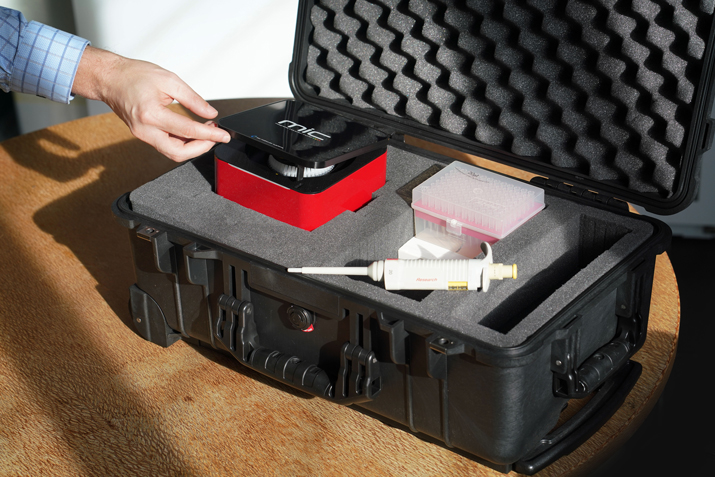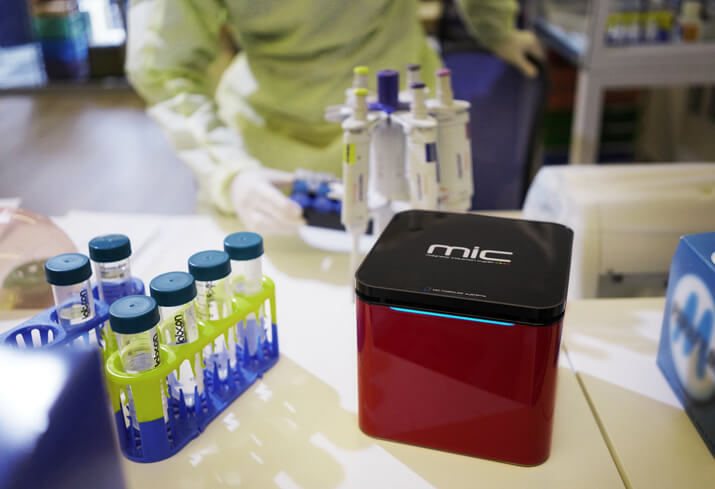As we’ve seen with COVID-19, the ability to rapidly roll out mobile testing facilities can literally save lives. This pandemic has given us a clear reminder that research, innovations and outbreaks won’t always be occurring where it’s convenient to set up a laboratory. As such, there’s an increasing need for portable qPCR solutions for less-than-traditional lab settings.
Here’s where qPCR is going mobile.
PCR portability isn’t just relevant to the most gung-ho of researchers clinging to the sides of cliffs. We’ve been seeing a lot of mobile testing taking place in these industries and applications in recent years:
- Food and beverage production, such as brewery sanitation
- Water and environmental testing and regulation
- AgTech, including aquaponics and livestock science
- Forensic sciences and anthropology research
- Remote and drive-through testing sites for outbreaks, most recently including COVID-19
- Disease research and management in animals – yes, including for bats.

Real time PCR has only become a truly portable option relatively recently, with portable options appearing on the market in 2013. Since Kary Mullis invented the polymerase chain reaction technique in 1984, most thermal cyclers have been lab-bound over the years. Traditional thermal cyclers are awkward, heavy and bulky – once they’re on your lab bench, they’re there to stay. They need steady operating environments and mains power to provide accurate and reproducible results. They also typically require expensive service contracts to keep them calibrated. Many lab managers still haven’t moved on from the typical PCR design, simply because they haven’t experienced the newly portable and agile options that are available.
But sample collection can occur anywhere – up mountains, on a ship in the middle of the ocean, in remote communities, in hospitals and on mine sites. Over the years, this has simply led to adaptation. Samples have been shipped, chilled, frozen, posted and driven to centralised lab facilities, often risking the integrity of samples as a result. Now, there’s a better way. Where once we brought the sample to the lab with costs, delays and risks – we can now bring that lab directly to the sample.
Is accurate qPCR analysis really possible outside of the lab? How to take qPCR out into the field
Since mobile real time PCR thermal cycler options first became available, the designs and features have improved exponentially. Portability doesn’t just relate to the size of the unit; it depends on a number of factors to ensure lab-worthy performance.
Here’s what to look for in a new-generation, portable qPCR solution:
• Size and structure
You’ll need a portable thermal cycler to be lightweight, tidy and compact, yet rugged. For example, by using magnetic induction technology we’ve managed to refine our Mic PCR machine down to just over 2kg so it can be carried in a case or even a backpack.
• Adaptable when it comes to power sources
In a remote community you might not have access to mains power, so battery and inverter operation might be necessary. Mic has run reliably off inverters via car and solar powered batteries.
• A realistic range of operating environments
You can’t control the weather wherever you go, but you can choose a thermal cycler that’s built for realistic operating environments. Mic can be run in temperatures between 18 and 35ºC and at humidity levels between 20% and 80%, for example.
• Robust communication
The last thing you want is to lose a run if your laptop or internet connection is patchy. Your thermal cycler should keep data on board until it’s retrieved, so you can start a run knowing you won’t have to go through the whole process again.
• Little to no maintenance
In 2020 and beyond you really don’t need to be paying for regular calibration services. We’ve refined Mic so it doesn’t need to be calibrated – ever. You can take it out of your pack, get set up and simply start your first run.
• Scalable
Although scalability isn’t essential for portability, the ability to add another thermal cycler to the system can be invaluable in changing scenarios such as disease outbreaks. Stack another Mic or two on top, and away you go.

Of course, the ultimate factor is going to be accuracy. If you don’t have this, you might as well commit to lugging samples back to a centralised lab. Mic’s magnetic induction cycler technology sets it apart here, because its unique spinning aluminium rotor provides greater temperature uniformity during both dynamic and static operations. The result is worry-free reproducibility and accuracy, even across multiple runs.
The advantages of portable qPCR
Once you have samples going directly from their source to your thermal cycler, the benefits of PCR portability become clear.
- Faster turnaround times for samples, which can be essential in rapidly changing or challenging environments. Read more on how rapid, mobile testing can make a real difference in an outbreak.
- Optimal sample integrity, with less need to factor in transport time or temperature variations during transport.
- Reduced reliance on cold chain processes, and the sample quality issues that can arise from this at times.
- Improved safety and containment of infectious disease samples, with less double handling.
- Significantly shorter real time PCR thermal cycler protocol times by using modern equipment.
The potential for portable PCR equipment is clear. With the right equipment you can get out of the temperature-controlled lab with its WiFi and electrical outlets, and get out into the field while maintaining accuracy and reliability – perhaps even improving it in some cases. It’s entirely possible to set up a mobile lab that can be towed by a truck, housed in a shipping container or at its most basic, carried in a couple of cases. The blueprint for a successful mobile field laboratory encompasses four factors: personnel and training; biosafety and biosecurity management and logistical support; and right at the centre of it all, equipment and methods. With the right equipment, the possibilities of portable PCR are endless.
Our Mic PCR instrument is being used across the world in rugged and real-world applications, ranging from the study of wobbly possum disease in New Zealand to testing for microorganisms in Poland’s tap water. You can view the latest articles here, or speak with us about trying Mic out for yourself.
